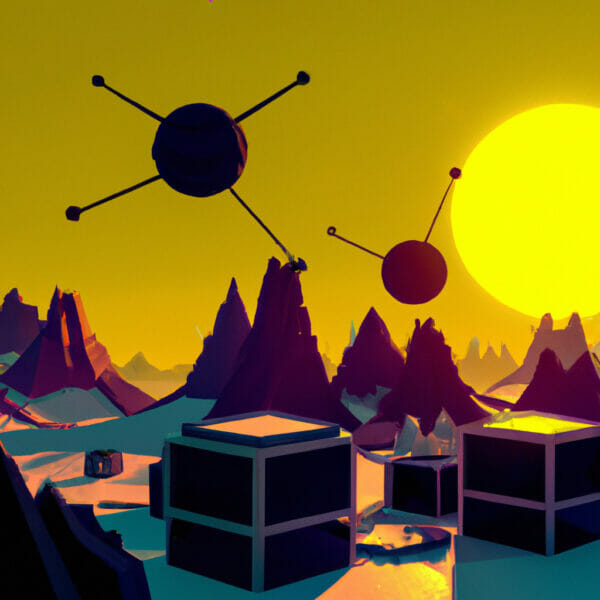Welcome to this comprehensive tutorial on the GDScript Integrated Development Environment (IDE). The world of programming can be vast and complex, but not all tools are created equal. GDScript IDE, with its simplicity and adaptability, particularly in game design, has become a valuable companion for both novice and experienced coders alike.
Table of contents
What is GDScript IDE?
GDScript IDE is a lightweight, user-friendly integrated development environment built specifically for the Godot game engine. It offers built-in GDScript coding assistance, ensuring coders can write, debug, and optimize their code more effectively.
What is it for?
GDScript IDE is designed to smooth the game development process. This is achieved by providing an interface where you can write code, debug errors, and manage your project files, all within a single environment.
Why Should I Learn It?
While there are many programming languages and tools available, learning GDScript IDE offers specific benefits:
- Adaptability: The GDScript language is similar to Python, one of the most popular and versatile languages in use today. This makes the transition to GDScript easier for existing Python coders while providing an excellent gateway language for programming newcomers.
- Game Design: The Godot game engine, for which the GDScript IDE is specifically designed, is a powerful and popular tool for amateur and professional game designers. Being proficient in GDScript enhances your Godot game design skills.
Whether you’re an experienced coder or just starting your journey into game design, the GDScript IDE offers a rewarding challenge with tangible benefits. Hang tight and enjoy this tutorial!
Setting Up GDScript IDE
Before we can start coding in GDScript, we need to set up our development environment. Here’s how you can do that:
# Step 1: Download Godot Engine Download the latest version of Godot engine from https://godotengine.org # Step 2: Extract Archive Extract the downloaded archive. This will create a new folder. # Step 3: Open Godot Run the Godot executable. This will open the project manager.
In the project manager, you create, remove, import, or run projects. For this tutorial, let’s create a new project.
# Step 4: Create New Project Click the 'New Project' button, choose a path for your project, and give it a name. # Step 5: Setup Project Click 'Create & Edit'. This opens the main editor where you'll be coding.
Writing Your First GDScript Code
To write your GDScript code, Godot provides a script editor right inside the engine. Here are some basic steps to start coding:
# Step 1: Open Script Editor In the main editor interface, click on 'Script' in the top menu. The script editor will open up. # Step 2: Create New Script Click on 'File' > 'New Script'. In the dialog box that opens, give your script a name and save it.
Now that we’ve created a new script, let’s write a simple “Hello, World!” program:
extends Node
func _ready():
print("Hello, World!")In this code snippet:
- extends Node: This line tells Godot that our script should inherit from the Node class.
- func _ready(): This is a function that Godot automatically calls when a node and its children have entered the scene and are ready.
- print(“Hello, World!”): This line simply prints the string “Hello, World!” to the output console.
To run your script, you’ll need to attach it to a node. In Godot, almost everything is a node. They are used to manage game logic, display graphics, play sound, and much more.
# Step 3: Create Object Select the '2D Scene' from the main menu to create a new 2D scene. # Step 4: Attach Script In the Scene dock, click on '+', name your node and click on 'Create'. then choose the 'Attach Script' button in the top right of the scene dock. In the pop-up window, select your script and click 'Open'.
There, we’ve covered the basics of setting up GDScript IDE and writing your very first script. In the next part, we’ll delve deeper into the GDScript language and explore more advanced topics.
Exploring GDScript Basics
Now that we have an understanding of how to use the GDScript Integrated Development Environment, let’s delve deeper into the peculiarities of the GDScript language.
Data Types
As with most programming languages, GDScript uses numerous data types, including integers, floats, booleans, strings, and arrays. Here are examples of how to use each of these:
var my_int = 10 var my_float = 3.14159 var my_bool = true var my_string = "Hello, GDScript!" var my_array = [1, 2, 3, 4, 5]
In GDScript, the ‘var’ keyword is used to declare a variable.
Operators
GDScript supports a variety of operators for performing operations on its data types. These include arithmetic, comparison, and logical operators, among others. To illustrate, let’s combine these data types and operators to perform operations:
var a = 5 var b = 10 var sum = a + b var diff = a - b var product = a * b var quotient = a / b print(sum, diff, product, quotient)
Control Flow
GDScript provides different control flow statements to alter the flow of execution. These include “if”, “else”, “elif”, and loops like “for” and “while”. Let’s look at some examples:
# If Statement
var x = 10
if x > 5:
print("x is greater than 5")
# For Loop
for i in range(5):
print("i is: ", i)
# While Loop
var count = 0
while count < 5:
print("count is: ", count)
count += 1Here, the “if” statement checks whether x is greater than 5, the “for” loop prints numbers from 0 to 4, and the “while” loop keeps printing and incrementing the “counter” value until it reaches 5.
Functions
A function is a block of code that performs a particular task and can be reused throughout your program. In GDScript, functions are defined using the “func” keyword. For example:
func greet(name):
print("Hello, " + name + "!")
# Call the function
greet("GDScript")In this code snippet, a function named “greet” is created which accepts a single argument “name”. The function prints a greeting using the argument. It is then called with the string “GDScript” as an argument.
As you can see, GDScript offers a vast variety of capabilities while maintaining simplicity and readability. Getting comfortable with GDScript will provide you with a solid foundation for your Godot game development journey. Next, we’ll explore advanced gameplay mechanics and how to implement them using GDScript.
Diving Deeper into GDScript
As we further explore the world of GDScript, let’s take a look at more advanced features of the language that you will find helpful while developing games with Godot.
Signals
One of the most powerful aspects of Godot and GDScript is the signal system. Signals allow nodes to communicate with each other without needing to understand the inner workings of the connected node. They basically act like an emission and reception system.
Here is a simple example of creating and emitting a signal:
# Create a signal named 'health_changed'
signal health_changed
# Emit the signal with a message
emit_signal("health_changed", "Player health changed")The signal ‘health_changed’ is declared at the top of the script using the ‘signal’ keyword. It can then be emitted anywhere in the script using ’emit_signal’.
Classes and Inheritance
GDScript is fully object-oriented and uses classes for scripts. Every script implicitly inherits from “Object”. However, different behaviors are provided by different nodes which classes can inherit from.
For example, let’s declare a simple class that models an enemy:
class_name Enemy
extends Node2D
var health = 100
func take_damage(damage):
health -= damageEach instance of the class “Enemy” would have a health property and a take_damage() method that changes the health by the passed amount in the argument.
But what if you needed different types of enemies? This is where inheritance comes in. Let’s create a Boss Enemy who will inherit from our original Enemy:
extends Enemy
var armor = 50
func take_damage(damage):
health -= (damage - armor)The “Boss” effectively inherits the attributes and functionality of “Enemy” but overrides the ‘take_damage’ function to incorporate the ‘armor’ attribute into the damage calculation.
Instancing Scenes
In Godot, everything is a scene. A scene can be a character, a button, a level, or any other kind of object. Each of these scenes can be easily instanced in others, resulting in reusability and organization.
For example, let’s instance an ‘Enemy’ scene into our ‘Game’ scene:
onready var enemy_scene = load("res://Enemy.tscn")
func start_game():
var enemy_instance = enemy_scene.instance()
add_child(enemy_instance)Here, ‘Enemy.tscn’ is loaded as the scene, and the instance of it is added as a child of the current scene (‘Game’) using the ‘add_child’ function.
Incorporating these advanced concepts in your GDScript knowledge inventory will allow you to develop complex games and applications with Godot. Now that you have a strong foundation of GDScript, we’re excited to see what you’ll create. Remember, keep exploring and keep coding!
How to Keep Learning
This tutorial was just a taste of what GDScript IDE and the Godot engine are capable of. But if you’re hungry for more, we have just the solution to satiate your growing curiosity. We invite you to check out our Godot Game Development Mini-Degree. This comprehensive program offers a deep dive into the Godot 4 engine, covering various aspects of game development, including 2D and 3D assets, GDScript programming language, gameplay control flow, and so much more!
With our Mini-Degree, you get to work on project-based courses spanning across different game genres, from platformers to RPGs, building your skills and portfolio along the way. Designed with flexible learning options for users of all levels, our program includes both live coding lessons and quizzes.
In addition to the Godot Game Development Mini-Degree, we also have a broad collection of Godot courses for you to explore, catering to a variety of interests and levels. Visit our Godot Courses page to find your next adventure.
Whether you are a novice or experienced developer, Zenva provides an inclusive learning space for everyone. Our mission here at Zenva is to empower our learners with the confidence and skills to navigate the exciting world of programming, game development, and AI. Let us accompany you in your journey from beginner to professional. Keep exploring, keep learning and keep pushing those boundaries!
Conclusion
Armed with the knowledge of GDScript and Godot, you’ve just powered up your game development journey. Whether it’s creating characters, designing game levels, or injecting life into your game with custom scripts, you now possess the skills to turn your game ideas into realities. Remember that the only limit is your imagination.
Let’s continue this journey together and make learning more exciting. We invite you to continue mastering your game development skills with Zenva by enrolling in our Godot Game Development Mini-Degree. Adventure for more knowledge awaits — Gear up, take that step, and let’s keep coding!
Did you come across any errors in this tutorial? Please let us know by completing this form and we’ll look into it!

FINAL DAYS: Unlock coding courses in Unity, Godot, Unreal, Python and more.







